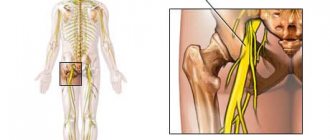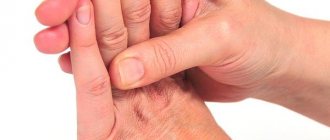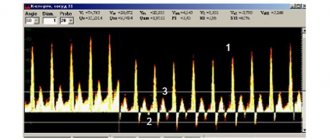12 April 2021
47080
0
3.1 out of 5
Numbness or hypoesthesia of the fingers is a rather unpleasant situation, which can be either a consequence of physiological reasons or a sign of various types of diseases. Therefore, if this symptom persists for an hour or more, and there is no improvement in rubbing your hands, clenching and unclenching your fists, you should consult a doctor. He will help you understand the reasons for its appearance and, if necessary, prescribe the necessary treatment. This will be the key to detecting pathology at an early stage of development and the success of therapy, and will also help to avoid aggravation of the situation and eliminate the risk of complications. After all, it is not so much the numbness of the fingers that is dangerous, although it can cause significant difficulties in performing everyday tasks, but the consequences of the lack of treatment for the diseases that provoked its occurrence.
Why do my fingers go numb?
Numbness and decreased sensitivity in the fingers may be a consequence of the development of neurological disorders and changes in their blood supply, which is caused by vascular pathologies. However, this can also occur as a result of such harmless factors as prolonged stay in an uncomfortable position, which compresses the blood vessels supplying the fingers. This is often observed in the morning when a person has just woken up, especially if during sleep he put his hand under his head or threw them behind it. In such situations, numbness is usually combined with tingling in the fingers of varying strength, as well as a feeling of loss of control over the hands. But all these symptoms go away on their own with the restoration of normal quality of blood circulation in the hands, which takes no more than 10-15 minutes.
Also, one of the physiological causes of numbness in the fingers is prolonged exposure to the cold. As a result of prolonged exposure to low temperatures, blood vessels reflexively contract. This leads to a decrease in the rate of blood circulation in the fingers and the occurrence of characteristic numbness, and sometimes aching pain. This is no longer as harmless as sleeping in an uncomfortable position, since this already indicates the possibility of frostbite on the fingers. Therefore, in such situations, it is necessary to take measures to warm your hands.
But, if your fingers often go numb and this feeling persists for a long time, you should look for the reason in:
- neurological disorders (tunnel syndrome, polyneuropathy, plexitis, etc.);
- traumatic injuries;
- vascular disorders, etc.
Sometimes fingers go numb while taking medications such as Isoniazid, Vincristine, Metronidazole.
Neuropathy, carpal tunnel syndrome and polyneuropathy
As for neurological disorders, a fairly large number of different diseases can manifest themselves in a similar way. First of all, these are neuropathies of various origins. This term refers to damage or compression of one or more nerves of the peripheral nervous system, one of the first symptoms of which is the occurrence of a crawling sensation and numbness. But if in the early stages of development this is observed only periodically, then as the pathology progresses, the fingers become numb more often and longer, pain occurs, changes in the condition of the skin are observed, and the muscles lose tone.
With inflammation of the nerve, bruise, prolonged compression of the arm, for example, with the habit of leaning on the elbows at work, or the action of other isolated factors, local neuropathies or tunnel syndromes may occur. In such cases, in addition to numbness, pain, weakness or awkwardness may be observed when moving or grasping objects with your fingers. The nature of their manifestation directly depends on which of the nerve trunks is damaged. So:
- numbness in the 1st, 2nd and partially in the 3rd fingers is characteristic of damage to the radial nerve;
- numbness of the little finger and ring finger up to half on the palm side and the 4th, 5th and part of the 3rd fingers on the back side is observed with damage to the ulnar nerve;
- numbness of the 1st, 2nd, 3rd and half of the 4th finger on the side of the palm and nails of 2-5 fingers is caused by damage to the median nerve;
- Numbness of 1-3 fingers and weakness when abducting the thumb are characteristic of the most common syndrome of the carpal or carpal tunnel, in which the median nerve is pinched in the flexor muscles of the wrist joint.
Carpal tunnel syndrome occurs in 1% of people and often occurs in those who have to work with a computer for long periods of time.
Fingers can also go numb as a result of the development of polyneuropathies, i.e., with simultaneous damage to a large number of nerves of the peripheral nervous system as a result of the development of certain systemic diseases. In such situations, numbness of the fingers on both hands is observed, and other symptoms characteristic of these pathologies may also appear.
This may be a consequence of diabetes mellitus, in which constantly high blood sugar levels lead to damage to nerve fibers, i.e. the development of diabetic neuropathy. But diabetes is more likely to affect the toes, although the hands can also suffer.
Fingers also become numb during development:
- chronic inflammatory demyelinating polyneuropathy;
- Roussy-Lévy syndrome;
- alcoholism, which led to the emergence of so-called alcoholic polyneuropathy;
- Refsum's disease;
- amyotrophic lateral sclerosis (ALS);
- Guillain-Barre syndrome;
- poisoning with chemicals and heavy metals.
Other neurological disorders
Some diseases can indirectly cause numbness in the fingers, but they are also characterized by a number of other symptoms, which makes it possible to differentiate them from neuropathies. These include:
- Cervical plexitis is a disorder that occurs when the nerves entering the cervical plexus are compressed by enlarged lymph nodes, cervical ribs or spinal structures as a result of the development of spondylosis, osteochondrosis, protrusion or intervertebral disc herniation of the cervical spine. It may also be the result of a birth injury or other damage to the cervical spine.
- Brachial plexitis is a neurological disorder that develops when the nerves that form the brachial plexus are pinched. It can occur as a result of injury to the collarbone, shoulder joint, the formation of an aneurysm (protrusion of the wall of a blood vessel), or a tumor. Sometimes brachial plexitis is observed in people against the background of dysmetabolic or infectious pathologies.
- Horner's syndrome is a neurological disorder that develops in response to damage to the sympathetic nerve fibers of the brachial plexus as a result of tumor formation, aortic aneurysm, thyroid dysfunction, and the development of multiple sclerosis.
Spinal diseases, in particular spondylosis, osteochondrosis, and intervertebral hernias, are among the most common causes of numbness in the fingers.
Injuries
Any bruises, fractures or other injuries to the hands, accompanied by severe swelling, can lead to short-term numbness of the fingers. This is a consequence of compression of the blood vessels by edematous tissue, which temporarily disrupts the blood supply. This can also be observed in the first days after applying a plaster cast to immobilize the injured arm and requires its prompt loosening.
It is extremely rare to observe the occurrence of myofascial compartment syndrome, which is characterized by numbness of the fingers and hands, severe pain that cannot be relieved with traditional non-narcotic drugs. This is a dangerous complication that requires immediate qualified medical care.
Also, numbness in the fingers immediately occurs after open wounds, during which the nerve trunks were damaged. But this is usually combined with noticeable limitations in mobility.
Patients who have suffered traumatic brain or spinal cord injuries often complain that their fingers go numb. At the same time, they have numbness constantly.
Vascular disorders
One of the possible causes of numbness may be hypertension, especially if it occurs without treatment. In such situations, the fingers usually go numb due to the development of swelling of the hands, which is combined with:
- redness of the face;
- increased sweating;
- long-term pain in the heart area.
Another cause of hypoesthesia can be anemia, i.e. a condition in which the number of red blood cells in the blood sharply decreases, and therefore the level of hemoglobin drops. Since this compound is responsible for transporting oxygen to cells, when it is deficient, signs of oxygen starvation are observed:
- feeling of weakness;
- increased fatigue;
- headache;
- decreased appetite;
- increased heart rate;
- shortness of breath even with minor physical exertion;
- decreased concentration;
- dizziness up to loss of consciousness.
Also, numbness in the fingers can be a consequence of a stroke.
Numbness in the fingers is also characteristic of Raynaud's syndrome. This is the name for a disorder in which there is a violation of arterial circulation in the 2nd and 4th fingers under the influence of cold or stress. It is characterized by a paroxysmal course with the initial appearance of a feeling of numbness, coldness and blueness of the fingers, which indicates a decrease in the intensity of blood circulation in them. Then these sensations are replaced by distension, aching pain and burning. When blood circulation is restored and, accordingly, the attack ends, a strong feeling of heat appears in the fingers, and they turn sharply red.
Raynaud's syndrome may be a sign of the development of diseases such as:
- rheumatoid arthritis;
- scleroderma;
- systemic lupus erythematosus;
- damage to the sympathetic ganglia or neurovascular bundles;
- some endocrine diseases;
- blood pathologies.
Less commonly, it occurs against the background of vibration disease and frequent hypothermia.
The tips of the thumbs go numb
Diseases in which the tips of the thumbs go numb are mainly associated with impaired capillary bed patency. This may be a consequence of a violation of the innervation of the vascular wall. But more often, angiopathy develops against the background of long-term negative effects of a toxic substance.
In the vast majority of cases, if a young person has numbness in the tip of the thumb on his right hand (or left), then during the collection of anamnesis it turns out that he has been smoking for several years. Tobacco smoke contains many toxic substances that spasm blood vessels. If they are large in lumen, then this has little effect at first. But this has a detrimental effect on small capillaries. First, the vascular wall collapses. Then it sticks together and the vessel becomes sclerotic. There is a complete lack of blood supply to the distal (remote) parts of the body. Typically, the tips of the fingers and toes are the first to be affected. If this process is not stopped, then over the next 5 to 7 years a person will develop obliterating endarteritis, which will entail the need for amputation of the affected limb.
If the tip of the thumb on your left hand becomes numb, then you need to exclude cardiac pathology and check the conduction of the nerve impulse along the median nerve. This may be a sign of developing carpal valve syndrome.
Diagnostics
Thus, there are quite a lot of diseases that can provoke hypoesthesia of the fingers. Therefore, if this symptom occurs regularly and persists for a long time, you should definitely consult a neurologist. The doctor will conduct a survey and examination of the patient, during which he will assess the condition of the skin, pulse strength, reflexes and conduct certain neurological tests to detect possible motor disorders. But to make an accurate diagnosis, this data is not enough. Therefore, depending on the detected signs, patients may be prescribed one or another diagnostic procedure from the following:
- electromyography and electroneurography - used to assess the degree and extent of damage to nerve trunks;
- X-ray or CT - used to detect deformities of the bones of the hands, tumors;
- angiography is a method used to assess the quality of blood circulation in the area of interest, in particular for diagnosing Raynaud's syndrome;
- Dopplerography of the vessels of the neck and head - is prescribed to detect cerebral circulation disorders and vascular pathologies;
- MRI is used to detect minute changes in soft tissue structures, the brain, and intervertebral discs.
A set of laboratory tests is also often prescribed, the results of which help to identify systemic diseases, for example, diabetes mellitus, anemia, endocrine disorders, rheumatoid diseases, etc.
Manifestations of finger paresthesia
With paresthesia, numbness, slight tightness of the fingers, and sometimes tingling are felt. Impaired sensitivity prevents you from grasping small objects or performing precise work with your fingers. Based on these signs, it is difficult to make a preliminary diagnosis, however, numbness in some diseases affects only certain fingers:
- Numbness in the little finger of the left hand, as well as the appearance of similar changes in the ring and middle fingers, can be caused by pathologies of the heart and blood vessels. Paresthesia is more pronounced at night;
- Numbness of the fingers of one hand that spreads to the hand occurs during a stroke. In the acute phase of cerebrovascular accident, coordination of movements is also impaired, consciousness becomes confused, and there may be paralysis of one side of the face;
- Numbness of the thumb, index and middle fingers on one of the hands or on both at once is one of the symptoms of compression of the nerves in the spine with osteochondrosis of the neck;
- Paresthesia of the thumb and index finger is a characteristic sign of carpal tunnel syndrome;
- Simultaneous numbness of the fingers on the lower and upper extremities often worries patients with diabetes.
If you complain about numbness, you can initially contact your GP. After examination and clarification of other symptoms of deterioration in well-being, the doctor refers you for examination to specialized specialists - a neurologist, cardiologist, endocrinologist, surgeon.
Treatment
For each patient, treatment is developed individually based on diagnostic results and detected diseases. In most cases, they begin by prescribing conservative therapy appropriate to the situation. It may include medication, physical therapy and exercise therapy.
Drug treatment may include drugs from different groups. They are selected based on the causes of numbness in the fingers, but they must take into account concomitant diseases, age and other characteristics of the patient. Typically used:
- NSAIDs - prescribed during an exacerbation of neuropathy to reduce the intensity of pain and eliminate swelling of soft tissues;
- corticosteroids - indicated for severe inflammatory processes, as well as complex neuropathy;
- B vitamins - used to improve the transmission of bioelectric impulses along nerve trunks;
- antiplatelet agents - prescribed to reduce blood viscosity and improve blood circulation;
- calcium antagonists - used to increase the lumen of blood vessels, which is indicated for Raynaud's syndrome;
To increase the effectiveness of drug treatment, physiotherapeutic procedures are often used. The most effective for neurological disorders are:
- electrophoresis;
- phonophoresis;
- laser therapy;
- UHF;
- electromyostimulation;
- applications with paraffin;
- ozocrete treatment;
- mud therapy.
To eliminate numbness, an individually developed complex of exercise therapy must be prescribed. It helps to develop the joints of the hands, activate blood circulation and relieve muscle tension. As a result, tissue trophism and innervation of the fingers improves. But exercise therapy should be done systematically, devoting the proper amount of time to gymnastics every day.
What to do?
If you don’t know why the thumb on your right hand is numb, then you should first visit a doctor and conduct a full examination. Our manual therapy clinic is attended by a neurologist. The initial consultation is provided completely free of charge for all patients. During the appointment, the doctor conducts a full examination and a series of diagnostic functional tests.
Then additional examination methods (x-ray, MRI, CT, electroneurography, electromyography, etc.) may be recommended. After making an accurate diagnosis, the doctor will develop an individual course of treatment.
So, if the unpleasant sensations are associated with damage to the cervical spine, then a traction procedure will first be performed in order to eliminate compression from the radicular nerves. Then a course will be developed to include sessions of massage, osteopathy, kinesiotherapy, therapeutic exercises, acupuncture, etc.
To treat other pathologies, the action of the pathogenic factor is also first eliminated, and then restorative therapy is carried out.
When is surgery needed?
There are a number of situations when conservative therapy does not allow one to get rid of the numbness in the fingers and other symptoms that bothers the patient, or the disease that provokes it poses a serious threat to the life and health of a person. In such cases, patients are recommended to undergo surgical intervention, the nature of which directly depends on the type of pathology detected.
So, the operation could consist of:
- removal of peripheral nerve tumors;
- neurolysis;
- decompression of compressed nerve structures;
- performing nerve plastic surgery for traumatic injuries;
- removal of cervical ribs;
- removal of aneurysms;
- removal of intervertebral hernias, etc.
Peripheral nerve tumor removal
This operation is required when benign or malignant tumors are detected that compress the peripheral nerve trunks. In the first case, it can be carried out by blunt desquamation from a capsule formed by connective tissue. Sometimes it becomes necessary to remove the damaged nerve fragment, after which it is repaired or sutured.
If fingers become numb as a result of the formation of neurofibromas, especially with multiple neurofibromatosis, surgical intervention is indicated only in cases where this benign neoplasm compresses the nerve trunk. This is due to the fact that the removal of one of the tumors can become an impetus for the formation of others, which can complicate the patient’s condition.
When diagnosing cancerous tumors, the operation involves removing the entire tumor, including healthy tissue and nearby lymph nodes. After this, patients are prescribed radiation therapy.
Neurolysis
Neurolysis or release of the nerve from the surrounding connective tissue scar tissue is used for:
- injuries of various types that caused nerve damage;
- compression of the nerve trunk by scar tissue;
- compression of the nerve by an aneurysm;
- failure of the nerve suture.
The goal of the operation is to restore normal nerve conduction. Therefore, it can act as a separate type of surgical intervention, or be only one of its stages.
Decompression of nerve trunks
This operation is performed when carpal tunnel syndrome develops as a result of compression of the nerve in the musculoskeletal canal of the wrist, etc. It is used when pain in the hand persists and there is a significant risk of developing muscle atrophy. The essence of this type of surgical intervention is to dissect the tissue that is compressing the nerve, and sometimes to move the nerve itself, followed by restoration of the anatomy of the musculoskeletal canal.
Plastic surgery and suture of nerve trunks
A nerve suture or neurorhaphy is required when the nerve trunk is ruptured as a result of a traumatic factor or after resection of its fragment during surgery. The essence of the method is the precise comparison of cross sections of the dissected nerve, followed by suturing its sheath or individual bundles.
Nerve repair is indicated when it is impossible to apply a suture due to the remote location of the remaining ends. It consists of using grafts taken from the patient’s other superficial nerves innervating the skin and using them to connect the remaining fragments of the injured nerve trunk. The autograft is fixed with sutures.
Removal of cervical ribs
If the fingers become numb due to the presence of an additional rib at the cervical vertebra, it is recommended to remove it in parts, but entirely along with the periosteum. For this purpose special forceps are used.
Aneurysm removal
The operation can be performed using different techniques, the choice of which directly depends on the location of the aneurysm:
- installation of a vascular stent or coil;
- applying a clip at the base of the aneurysm neck.
Removal of intervertebral hernias
Operations of this type are performed when fingers become numb as a result of the formation of protrusions or hernias in the intervertebral discs of the cervical spine. They can be carried out in different ways, including by:
- hydroplastics;
- nucleoplasty;
- endoscopic hernia removal;
- microsurgical operation.
In all cases, by removing the protrusion of the disc, decompression of the spinal root responsible for the innervation of the arm and fingers is carried out.
Thus, numbness of the fingers can be either a harmless situation, or be a consequence of an injury, or indicate the development of quite dangerous diseases, including the spine. Therefore, when this symptom appears, it is important not to hesitate and immediately contact a neurologist or spinal surgeon.
Treatment for numb fingers
Numbness in the fingers that occurs for pathological reasons will continue to bother you until the underlying disease is treated. Therapy for paresthesia is selected by the doctor who is involved in eliminating the identified causes of the pathology. Complex treatment includes medications, physiotherapy, finger exercises, massage, and warming ointments. You can also use folk remedies; their use shows excellent results if numbness in the fingers is caused by physiological reasons.
Treatment of numbness in the fingers takes from several days to several months. The duration of the course primarily depends on the root cause of the pathology.
Many people put up with periodically disturbing sensitivity problems in their fingertips. But this is an extremely wrong attitude towards one’s own health - numbness is often the initial sign of quite serious diseases. If these diseases are treated in a timely manner, then acute life-threatening complications can be avoided, therefore, when paresthesia appears that is not caused by physiological reasons, a thorough diagnosis is required.
In our clinic, experienced neurologists, therapists, and endocrinologists will conduct diagnostics, establish the diagnosis as accurately as possible and prescribe comprehensive treatment under dynamic supervision.
Among our methods, we use acupuncture, manual therapy, all types of massage, physiotherapeutic procedures and physical therapy under the supervision of an experienced specialist. Don't put off the problem until later. In this situation, it is necessary to make decisions quickly.
Diagnosis of diseases causing numbness
Since decreased sensitivity in the fingers of the left hand may indicate vascular pathologies and portend a stroke, first of all, you should go to a cardiologist. If, during the diagnosis, the doctor does not find the causes of the symptom in “his area”, consultation with other specialized specialists will be required: a surgeon, a vertebrologist and a neurologist.
When differentially diagnosing the causes of numbness in the fingers, the following methods can be used:
- General blood and urine tests are required to identify infectious lesions and endocrine pathologies.
- X-rays of the cervical spine are recommended to be taken in several projections. This is necessary to accurately record the localization of zones of compression of nerve fibers and blood vessels.
- Doppler ultrasound of the vertebral artery is performed to assess the patency of an important vessel supplying the brain.
- Based on the results of CT and MRI, the condition of the cervical spine and large blood vessels lying in this area is assessed.
- Electro- and echoencephalography are necessary to assess the functionality of parts of the brain.
During these diagnostic measures, it is revealed what caused the numbness of the fingers of the left hand. Treatment of the symptom will consist of complex therapy of the underlying disease.
Conservative treatment of diseases
In most cases, numbness in the fingers is neurological in nature and is caused by compression of nerve fibers in the neck or directly on the left arm. Complex therapy for paresthesia is aimed at eliminating pinching, muscle spasms and their consequences. The treatment program includes the following drugs:
- anti-inflammatory steroidal and non-steroidal drugs (Diclofenac, Ketoprofen, Nimesulide, Ambene);
- drugs that improve blood circulation (Detralex, Tanakan, Cavinton);
- antispasmodics (No-shpa, Mydocalm);
- chondroprotectors (Teraflex, Rumalon, Chondroxide, Artron flex);
- multivitamins.
In addition to taking medications, manual therapy of the affected area and therapeutic exercises are used to improve the condition of patients. Such measures can eliminate muscle spasms, restore vertebral mobility and improve trophism. Courses of physiotherapeutic procedures (magnetic therapy, ultrasound and laser treatment of affected areas), hirudotherapy and acupuncture have a positive effect on the dynamics of relieving unpleasant symptoms.
Persistent numbness of the fingers of the left hand, the causes of which are vascular pathologies, requires complex and lifelong treatment under the supervision of a cardiologist.
Taking the prescribed medications will prevent the formation of plaques on the walls of blood vessels and improve the elasticity of the veins and arteries.










